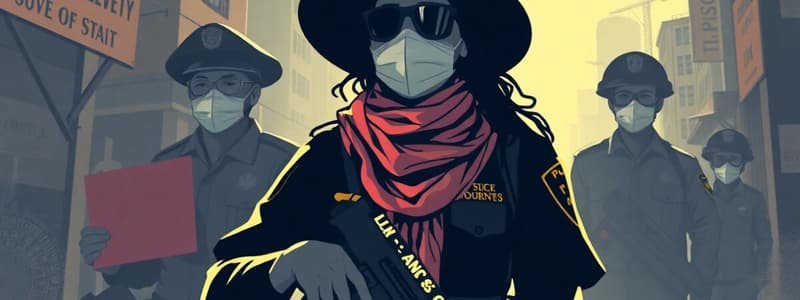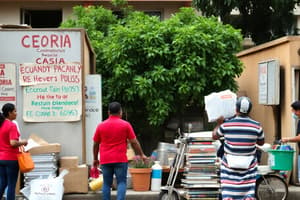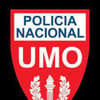Podcast
Questions and Answers
What effect does the criminalization of poverty have on less vulnerable groups?
What effect does the criminalization of poverty have on less vulnerable groups?
- It makes them more politically influential. (correct)
- It increases their financial security.
- It encourages them to invest in punitive measures. (correct)
- It decreases their interest in welfare issues.
What measures have Canadian governments taken to manage welfare support?
What measures have Canadian governments taken to manage welfare support?
- Increased funding for welfare
- Promoted community support programs
- Reduced benefits and restricted eligibility (correct)
- Eliminated surveillance of recipients
How have race and gender interplay affected the patterns of penalization related to poverty?
How have race and gender interplay affected the patterns of penalization related to poverty?
- Only racialized people are affected by penalization practices.
- They have made men less susceptible to poverty.
- They have increased the benefits available to all groups.
- Women and racialized minorities are more likely to face disciplinary measures. (correct)
What role do workfare programs play in the governance of poverty?
What role do workfare programs play in the governance of poverty?
What is a significant factor that has influenced the transformation of state practices in governance concerning poverty and welfare?
What is a significant factor that has influenced the transformation of state practices in governance concerning poverty and welfare?
What is a primary aim of law-and-order policing in the context of neoliberal policies?
What is a primary aim of law-and-order policing in the context of neoliberal policies?
How does law-and-order policing function in relation to gentrification?
How does law-and-order policing function in relation to gentrification?
Which of the following best describes the neoliberal project?
Which of the following best describes the neoliberal project?
What is one of the main consequences of law-and-order policing as viewed by social activists?
What is one of the main consequences of law-and-order policing as viewed by social activists?
What underlying issues accompany law-and-order policing in the context of economic restructuring?
What underlying issues accompany law-and-order policing in the context of economic restructuring?
How does neoliberalism contribute to structural insecurity?
How does neoliberalism contribute to structural insecurity?
What is a consequence of the criminalization of poverty according to the content?
What is a consequence of the criminalization of poverty according to the content?
How does the criminalization of poverty reframe vulnerability?
How does the criminalization of poverty reframe vulnerability?
What societal factors are masked by the criminalization of poverty?
What societal factors are masked by the criminalization of poverty?
What is a key implication of viewing individuals as 'responsible' or 'irresponsible' in the context of neoliberalism?
What is a key implication of viewing individuals as 'responsible' or 'irresponsible' in the context of neoliberalism?
Which of the following best describes the relationship between state policies and the criminalization of poverty?
Which of the following best describes the relationship between state policies and the criminalization of poverty?
What role do stigmatized individuals play in a neoliberal society?
What role do stigmatized individuals play in a neoliberal society?
What does the criminalization process suggest about the state's approach to vulnerable populations?
What does the criminalization process suggest about the state's approach to vulnerable populations?
What misconception contributes to the belief that women of color have children primarily to obtain welfare money?
What misconception contributes to the belief that women of color have children primarily to obtain welfare money?
How do punitive welfare reforms disproportionately affect marginalized groups?
How do punitive welfare reforms disproportionately affect marginalized groups?
What is a consequence of criminalizing the activities of poor people under policies like the Safe Streets Act?
What is a consequence of criminalizing the activities of poor people under policies like the Safe Streets Act?
What is a misleading assertion about welfare fraud?
What is a misleading assertion about welfare fraud?
What assumption have recent welfare reforms made about poor individuals, according to Gustafson?
What assumption have recent welfare reforms made about poor individuals, according to Gustafson?
Which method of monitoring welfare recipients is mentioned as a current practice?
Which method of monitoring welfare recipients is mentioned as a current practice?
What do critics argue about the Safe Streets Act policies?
What do critics argue about the Safe Streets Act policies?
What is a common misconception about the relationship between poverty and criminal activity?
What is a common misconception about the relationship between poverty and criminal activity?
What effect have welfare reforms had on women's vulnerability to abusive men?
What effect have welfare reforms had on women's vulnerability to abusive men?
How do deep cuts to benefits impact women's relationships with abusive men?
How do deep cuts to benefits impact women's relationships with abusive men?
What does the expanded definition of spouse imply for women seeking welfare?
What does the expanded definition of spouse imply for women seeking welfare?
What strategy do abusive men employ to manipulate women vulnerable due to welfare reforms?
What strategy do abusive men employ to manipulate women vulnerable due to welfare reforms?
What ideological shift has significantly impacted welfare policies?
What ideological shift has significantly impacted welfare policies?
What was a significant societal view toward single mothers prior to the adoption of the Mother’s Allowance Act in 1930?
What was a significant societal view toward single mothers prior to the adoption of the Mother’s Allowance Act in 1930?
Which principle was legally encoded by the British new poor laws of 1834?
Which principle was legally encoded by the British new poor laws of 1834?
What motivated female reformers in the late 19th and early 20th centuries to advocate for public assistance?
What motivated female reformers in the late 19th and early 20th centuries to advocate for public assistance?
In what year was the Nova Scotia Mothers’ Allowance Act enacted?
In what year was the Nova Scotia Mothers’ Allowance Act enacted?
What kind of language characterized the annual reports of the Mothers’ Allowance in the 1930s?
What kind of language characterized the annual reports of the Mothers’ Allowance in the 1930s?
In the hierarchy of motherhood established in the 1970 Provincial Social Assistance Act, which group was considered most worthy?
In the hierarchy of motherhood established in the 1970 Provincial Social Assistance Act, which group was considered most worthy?
Why did reformers exclude unwed mothers from receiving public assistance?
Why did reformers exclude unwed mothers from receiving public assistance?
What was the societal perception of unmarried mothers in comparison to other mothers during the formulation of the social assistance hierarchy?
What was the societal perception of unmarried mothers in comparison to other mothers during the formulation of the social assistance hierarchy?
Flashcards
Neoliberalism
Neoliberalism
A system where individuals and businesses compete in free markets, with minimal government intervention. It prioritizes individual liberty, free trade, and limited government involvement in the economy.
Criminalization of Poverty
Criminalization of Poverty
The process of defining certain behaviors as criminal, particularly when those behaviors are associated with poverty, and making the poor more vulnerable to police and criminal justice systems.
Individualization of Poverty
Individualization of Poverty
The idea that poverty is a result of individual choices, bad decisions, or lack of effort, rather than systemic issues like economic inequality, discrimination, or lack of opportunity.
Neoliberal Policies and Inequality
Neoliberal Policies and Inequality
Signup and view all the flashcards
Security, Policing, and Criminal Justice
Security, Policing, and Criminal Justice
Signup and view all the flashcards
State Withdrawal and Individual Responsibility
State Withdrawal and Individual Responsibility
Signup and view all the flashcards
Criminalization and State Withdrawal
Criminalization and State Withdrawal
Signup and view all the flashcards
Neo-Liberal Crime Control
Neo-Liberal Crime Control
Signup and view all the flashcards
Racialization
Racialization
Signup and view all the flashcards
Workfare Programs
Workfare Programs
Signup and view all the flashcards
Surveillance and Policing of Poverty
Surveillance and Policing of Poverty
Signup and view all the flashcards
Penalization of Women & Minorities
Penalization of Women & Minorities
Signup and view all the flashcards
Law-and-Order Policing
Law-and-Order Policing
Signup and view all the flashcards
Neoliberalism and Social Problems
Neoliberalism and Social Problems
Signup and view all the flashcards
Culture of Dependency Myth
Culture of Dependency Myth
Signup and view all the flashcards
Pathologizing Poverty
Pathologizing Poverty
Signup and view all the flashcards
Hypersexualization of Women of Color
Hypersexualization of Women of Color
Signup and view all the flashcards
Welfare Queen Myth
Welfare Queen Myth
Signup and view all the flashcards
Punitive Welfare Reforms
Punitive Welfare Reforms
Signup and view all the flashcards
Criminalizing Poverty
Criminalizing Poverty
Signup and view all the flashcards
Welfare Fraud Justification
Welfare Fraud Justification
Signup and view all the flashcards
Surveillance of Welfare Recipients
Surveillance of Welfare Recipients
Signup and view all the flashcards
Punitive Approach to Single Mothers Before 1930
Punitive Approach to Single Mothers Before 1930
Signup and view all the flashcards
Shifting Moral Ground: Widows and Public Assistance
Shifting Moral Ground: Widows and Public Assistance
Signup and view all the flashcards
Moral Hierarchy Among Widows
Moral Hierarchy Among Widows
Signup and view all the flashcards
Unmarried Mothers and Public Assistance
Unmarried Mothers and Public Assistance
Signup and view all the flashcards
Hierarchy of Motherhood in the 1970 Act
Hierarchy of Motherhood in the 1970 Act
Signup and view all the flashcards
Less Eligibility and Poverty
Less Eligibility and Poverty
Signup and view all the flashcards
Study Notes
CRM 515: Gendering Justice
- Criminalizing Poverty: This lecture explores the criminalization of poverty within the context of neoliberalism.
- Neoliberalism and Criminalization: The shift from collective risk management to individualized responsibility is a key element of contemporary liberal capitalist societies.
- Welfare Liberalism: This framework emphasized socialized risk and responsibility through welfare programs and economic partnerships between capital and state. Keynesian economics played a significant role.
- Advanced Liberalism/Neoliberalism: This approach focused increasingly on individual responsibility and risk mitigation, often criminalizing those perceived as problematic. State actors and private entities have contributed to this shift.
- Dynamics of Neoliberalism: Neoliberalism fortifies market capitalism through explicit and implied criminalization of non-market activities. It disguises structural vulnerabilities (racism, patriarchy) as individual failings.
- The "Undeserving" Poor: Poor people are often constructed as morally deficient, reinforcing market-driven ideas of responsibility. Racialized and gendered imagery perpetuates this.
- Racialization and Criminalization of Poverty: Punitive measures targeting immigration and welfare are linked to criminalizing the poor and racial minorities. Reduced benefits, increased surveillance, and disciplinary systems are common strategies.
- Rolling Back State Support: Current policies emphasize work ethics and personal responsibility, shifting blame to individuals rather than addressing structural issues.
- Law and Order Policies: Policing has become a key element of neoliberal strategies in Canada's cities, responding to perceived resistance to the new market economy.
- Locating the Emergence of Law-and-Order Policing: Zero-tolerance policing and aggressive policing practices emerged in the 1970s and 80s in response to economic hardship.
- Policing and Resistance to the New Labour Market: Law and order policing is a direct response to working-class resistance against the new labour market, focusing on issues of vagrancy and panhandling.
- From Welfare Fraud to Welfare as Fraud: Government attacks on welfare policies have disproportionately affected poor women.
- Double Taxonomy of Moral Regulation: Hall's work highlight the complexities of moral regulation, emphasizing both constraint and freedom/leniency. "Self-regulation" as inextricably linked to public regulation.
- Reforming Welfare in the 1990s: Reforms illustrate the shift from welfare fraud to welfare as fraud in Ontario focusing on case studies and statistical data.
- Moral Regulation Revisited: The entry of women into the workforce altered prevalent norms about women's roles, altering the perception of "deserving" vs. "undeserving" women.
- Women, Welfare, and the "Never Deserving" Poor: Welfare reforms disproportionately affected women, often creating conditions where these women faced increased vulnerability.
- "A Bad Time to Be Poor": Neo-liberal economic and political shifts intensify poverty for recipients, particularly single mothers. Changes to the definition of spouse highlight new social standards.
- Regulating, Punishing, and Excluding Single Mothers on Social Assistance: These policies disproportionately affect single mothers through regulations, restrictions, and sanctions.
- Current Application of the Man-in-the-House Rule: The application and enforcement of anti-fraud regulations often target single mothers, particularly immigrant women.
- Mothers' Allowance: The Genesis of the Penis Police: Historical development of welfare policies reveals moral judgments towards women in poverty.
- Unmarried Mothers and the Hierarchy of Motherhood: The hierarchy of mother- hood was constructed to differentiate "deserving" and "undeserving" mothers.
- The Family Benefits Act: The Act formalized rules that made it more difficult for single mothers receiving welfare assistance to have access to the program.
- A Class Analysis of the Man-in-the-House Rule: The rule perpetuates class inequalities and criminalizes the poor, especially single mothers.
- Women, Fear of Crime, and the Criminalization of Poverty in Toronto: Women's fear of crime is used to justify criminalizing those in poverty.
- The Ontario Safe Streets Act, 2000: The act criminalized behaviors often associated with urban poverty.
- Protective Men and Victimized Women: Men's Concerns for Female Safety: Gendered representations of poverty and safety are used to justify criminalizing behaviors of the poor, framing women as victims.
Studying That Suits You
Use AI to generate personalized quizzes and flashcards to suit your learning preferences.





